Kids as young as 2 or 3 can start kayaking by sitting in a tandem kayak. This shows how easy and fun kayaking can be for families. Kayaking lets you bond, explore nature, and teach your kids to love the outdoors.
It’s perfect for calm lakes or gentle rivers. Kayaking with kids is a great way to make memories. And, it’s safe if you follow the right steps.
This guide will give you tips for safe and fun kayaking trips. You’ll learn how kayaking benefits your kids and what safety steps to take. So, get your paddles ready for an exciting water adventure!
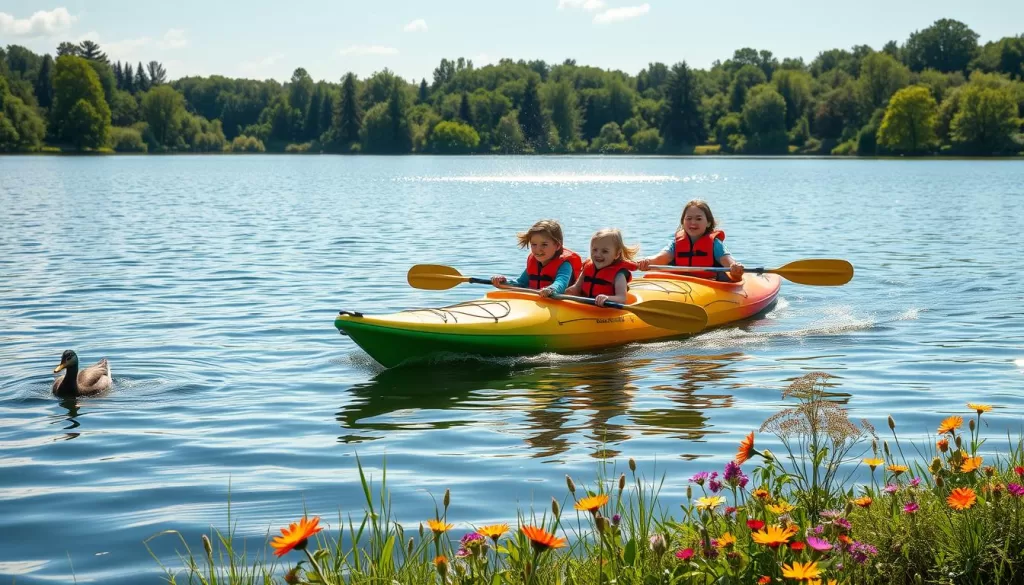
Key Takeaways
- Kids can start kayaking in tandem kayaks as early as age 2.
- Children under 13 must wear U.S. Coast Guard-approved life jackets.
- Supervision is critical; have one adult for every child until skills are proven.
- A larger, stable kayak enhances safety and enjoyment for kids.
- Plan your kayaking route with breaks and necessary supplies for a fun day.
- 1 Introduction to Family Kayaking Adventures
- 2 Benefits of Kayaking for Kids
- 3 Choosing the Right Kayak for Your Family
- 4 Best Age to Start Kayaking with Kids
- 5 Safety Tips for Kayaking with Kids
- 6 Kayaking Skills for Young Paddlers
- 7 Planning Your Family Kayaking Trip
- 8 What to Pack for a Successful Kayaking Excursion
- 9 Fun Activities While Kayaking with Kids
- 10 Maintaining Safety During Your Kayaking Adventure
- 11 Encouraging Interaction and Bonding
- 12 Kid-Friendly Paddling Destinations
- 13 Participating in Kayaking Lessons
- 14 Kayaking with Kids: Creating Lasting Memories
- 15 Conclusion
- 16 FAQ
- 17 Source Links
Introduction to Family Kayaking Adventures
Kayaking lets you and your family explore beautiful waterways together. It’s a great way to spend quality time outdoors. You’ll navigate through serene lakes, winding rivers, and scenic coasts. This activity helps kids connect with nature and sparks their sense of adventure.
Choosing the right kayaking spots is key for a fun family trip. There are many types of kayaks to pick from, each suited for different needs. Sit-on-top kayaks are great for beginners because they’re stable. Sit-inside kayaks are for those with more experience.
It’s important to know what equipment you need for safety and fun. Kids as young as three can start kayaking with an adult. This makes it a great activity for families with little ones.
Kayaking is not just fun; it also helps kids become more independent and resilient. It’s an affordable way to enjoy the outdoors together. This makes it a great choice for families looking for budget-friendly activities.
Benefits of Kayaking for Kids
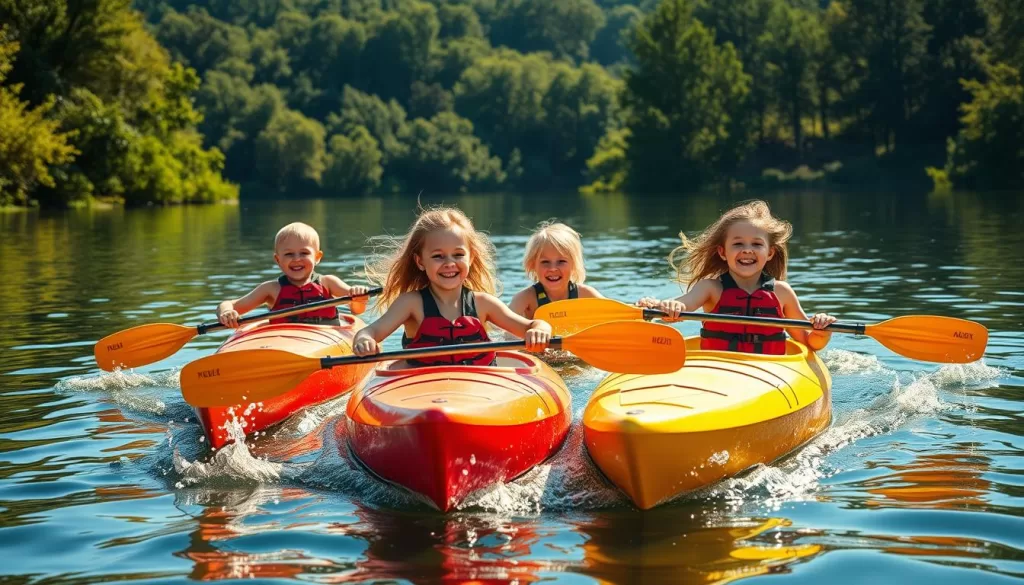
Kayaking is more than just a fun activity for kids. It helps them connect with nature and learn important life skills. As they paddle, they get physically fit and grow in their development.
Fostering a Love for Nature
Kayaking lets kids see the world from a new perspective. They get to see beautiful landscapes and wildlife up close. This helps them care more about the environment.
As they learn to love nature, they might keep exploring it for years. This can turn into a deep passion for the outdoors.
Building Confidence and Resilience
Kids grow more confident as they learn to navigate the water and paddle well. Every successful trip makes them feel proud. This builds resilience, teaching them to face challenges head-on.
Sharing these experiences with family makes the journey even better. It helps kids learn to work together and communicate. This strengthens family bonds.
Encouraging Physical Activity
Kayaking is a great way to stay active. It works many muscles and boosts heart health. It’s also a fun way for kids to move without the stress of competitive sports.
This activity is easy on young bodies, making it perfect for families. It’s a way to enjoy time together while staying fit.
Choosing the Right Kayak for Your Family
Finding the perfect kayak for your family can greatly enhance your water adventures. It’s important to know the different types of kayaks out there. Think about size, weight capacity, and stability when picking a family kayak.
Types of Kayaks: Single vs. Double Kayaks
There are various kayaks, each with its own purpose. Single kayaks are great for solo paddlers who want to explore on their own. Double kayaks, however, are perfect for family trips. They let two people paddle together, which is great for teamwork and teaching kids.
Inflatable Kayaks vs. Rigid Kayaks
When picking a kayak for your family, you might look at inflatable or rigid options. Inflatable kayaks are light and easy to carry, ideal for those with little storage. They’re also easy to set up and down. Rigid kayaks, though, offer more stability and a smoother ride, which is good for different water conditions.
Child-sized kayaks and Paddles
It’s key to get the right kayak size for kids to ensure they’re happy and comfortable. There are kayaks and paddles made just for kids to help them paddle better. Make sure they wear a PFD that fits well for safety. As they get older and more confident, they can move to the front seat of the kayak.
Best Age to Start Kayaking with Kids
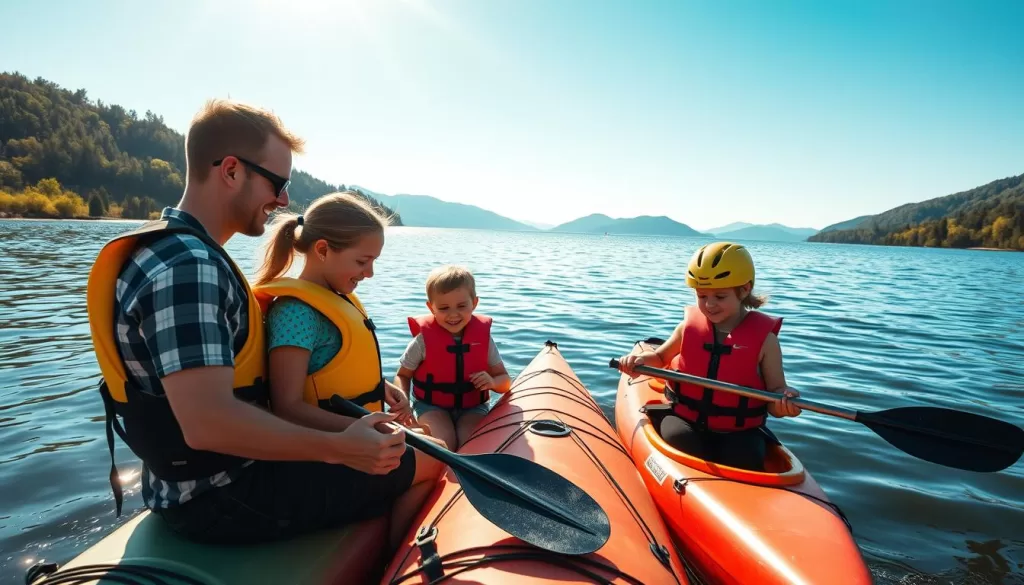
Finding the perfect age to start kayaking with your kids is key for a great time. It’s important to know when they are ready to begin. This ensures they have fun and stay safe. Think about when to start and the different stages kids go through as they learn.
Young Children: Riding in Tandem Kayaks
For little ones, tandem kayaks are a great way to start. Kids as young as 2 can try kayaking this way, feeling safe with parents nearby. It helps them get used to the water and feel secure.
- Kids aged 4 to 7 can ride as non-paddling passengers on a tandem kayak.
- Starting at age 5, kids often feel ready to use their own child-sized kayak.
- Learning to paddle starts with short times in calm water.
Learning to Paddle Independently
As kids get older, they become more ready for kayaking. Around age 5, they can paddle on their own. By age 8, they can be a bow paddler in tandem kayaks, improving their skills.
- Children aged 7 to 9 can paddle up to half a mile in calm waters.
- Most kids between ages 9 and 11 can paddle more than half a mile.
- Once they turn 14, many can handle a medium-sized kayak alone.
Safety Tips for Kayaking with Kids
Getting ready for a safe kayaking trip with your kids means being prepared and knowing what to do. It’s important to follow key safety tips to make sure everyone has a good time. Knowing about life jackets, water safety, and where you’re kayaking is key for keeping kids safe.
Importance of Life Jackets
Life jackets, or Personal Flotation Devices (PFDs), are essential for any kayaking trip with kids. Every child should wear a life jacket that fits well while in the water. Kids under 13 should always wear a PFD. It’s important to pick the right size for your child to ensure they stay buoyant and comfortable. Making wearing life jackets a habit teaches kids about safety.
Understanding Water Safety Rules
Clearwater safety rules make kayaking safer. Talk to your kids about important rules like:
- Always stay seated in the kayak.
- Don’t lean out of the kayak.
- Keep your hands and feet inside the kayak.
- Stay close to the adult who is steering the kayak.
These rules help keep everyone safe and teach kids to be responsible.
Know Your Kayaking Location
Picking the right place for kayaking is crucial for a safe and fun trip. Look for calm waters like small lakes, slow rivers, and quiet bays. These spots are safer for kids because they don’t have strong currents. Always check the weather before you go out. Planning shorter trips for younger kids helps prevent them from getting too tired or overwhelmed.
| Age Group | Recommended Activity | Safety Precautions |
|---|---|---|
| 2-5 years | Passenger in a tandem kayak | Always wear a PFD |
| 5-7 years | Paddling with an experienced adult | Discuss safety rules and features |
| 8-10 years | Helping paddle in tandem kayaks | Avoid strong currents |
| 10+ years | Paddling independently (with supervision) | Check weather conditions before trips |
These safety tips will help you and your family have fun and stay safe on the water. They make sure you enjoy your time together while keeping safety first.
Kayaking Skills for Young Paddlers
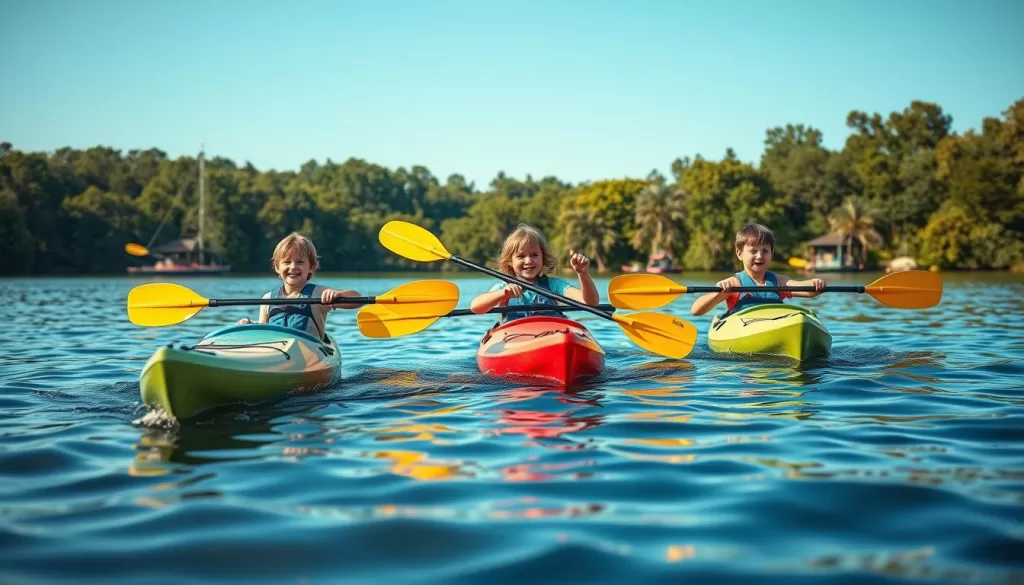
Starting a kayaking adventure requires young paddlers to learn key skills for fun and safety, and knowing basic paddling techniques builds their confidence in the water.
Basics of Paddling Techniques
Teaching kids the basics of paddling boosts their skills. Focus on these key points:
- Correct Paddle Grip: Make sure they hold the paddle with both hands, keeping their knuckles aligned.
- Body Position: Encourage a comfortable sitting position, keeping the back straight for better balance.
- Strokes: Show them forward strokes, reverse strokes, and turning techniques to control the kayak.
Mastering these basic techniques lets kids feel in control. This builds a love for kayaking.
Developing Paddling Endurance
Endurance is key for longer kayaking trips. Start with short trips and gradually increase the time. Here are some tips:
- Start Short: Begin with brief outings to keep them engaged and avoid getting tired.
- Breaks: Take breaks for snacks and water to keep their energy up.
- Encouragement: Celebrate their progress to boost their confidence.
Building endurance prepares kids for longer trips. It keeps them excited about kayaking.
Planning Your Family Kayaking Trip
Choosing the right spot for kayaking with kids is key to a great experience. Look for places that are safe and fun for families. Calm lakes, slow rivers, and bays are perfect because they have little waves and gentle currents.
Selecting Family-Friendly Locations
Find places with beautiful views and safe spots to land. This makes the trip more fun and keeps kids interested. Parks with kayaking areas are great for family fun and safety.
Checking Weather Conditions
Always check the weather before you go kayaking. The right weather makes for a safe and fun trip. Aim for calm or mild conditions. Avoid going out in windy or stormy weather.
Duration of Kayaking Trips
Begin with short trips, 15 to 30 minutes of paddling, for young kids. This helps prevent them from getting tired. As they get more comfortable, you can make the trips longer. Take breaks for snacks or to explore and make it more fun.
What to Pack for a Successful Kayaking Excursion
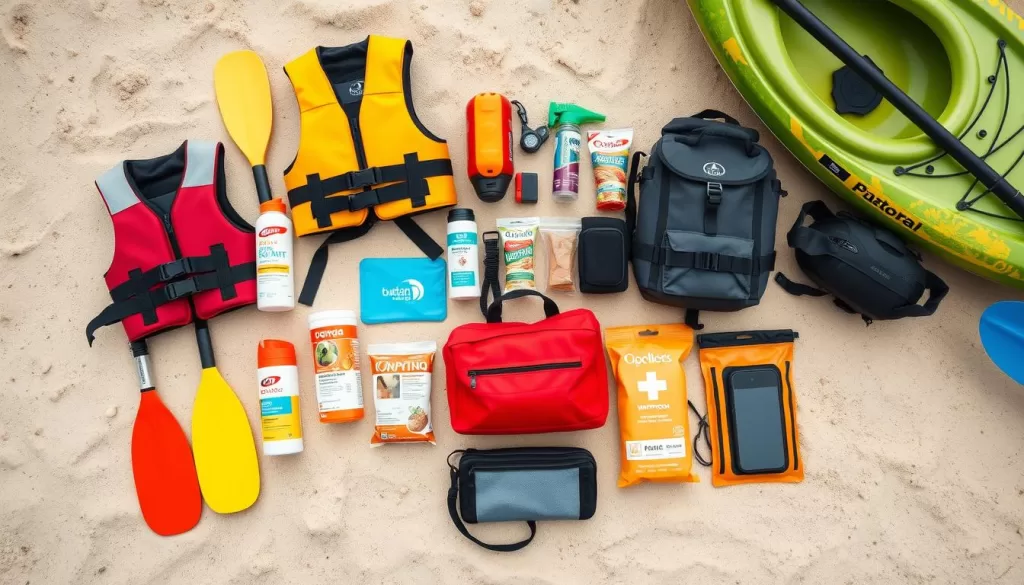
Getting the right gear is key for a fun and safe family kayaking trip. Make sure your kayaking packing list has everything you need. This way, everyone can have a great time on the water, especially the kids.
Life Jackets and Safety Gear
Every family member needs an approved life jacket. Also, buoyancy aids in achieving more freedom in the water. Don’t forget safety items like whistles and a first aid kit. Knowing how to stay safe makes the trip enjoyable for everyone.
Snacks and Water Bottles
It’s important to keep your family hydrated and fed during the trip. Bring lots of water and snacks to keep your energy up. Juice boxes, granola bars, and fruit are great choices. Having these items on your kayaking packing list keeps everyone happy and energized.
Clothing Considerations for Kayaking
Choose clothes that dry quickly, like nylon or polyester, for kayaking. Also, pack swimwear and clothes with UPF protection for sun safety. Layering is a good idea since the weather can change. This way, you stay comfortable while paddling.
Fun Activities While Kayaking with Kids
Kayaking with your kids opens up exciting ways to learn and connect. It helps them appreciate nature and have fun on the water. Here are some great activities to try on your next adventure.
Wildlife Watching
Kayaking lets families see amazing wildlife up close. You can spot birds, fish, and other creatures as you paddle. This makes memories that last forever and teaches kids to respect nature.
Encourage them to use binoculars and guides to learn more about the ecosystem.
Exploring Hidden Coves
Kayaking lets you reach places you can’t get to on foot. You can find hidden coves and small islands. These spots are perfect for picnics, relaxing, or swimming in calm waters.
Let your kids lead the way in exploring. Their curiosity will help you discover new things.
Outdoor Games on the Water
Adding games to your kayaking trip makes it more fun. Try games like “I Spy” or relay races. These games keep kids active and teach them about teamwork.
You could also do water races or scavenger hunts. This makes your time on the water both fun and interactive.
| Activity | Description | Benefits |
|---|---|---|
| Wildlife Watching | Spotting animals and plants during your kayaking trip | Increases awareness and connection to nature |
| Exploring Hidden Coves | Discovering secluded spots that are only reachable by kayak | Encourages adventure and imagination |
| Outdoor Games | Engaging in games like relay races or scavenger hunts | Boosts physical activity and fun among family members |
These activities offer endless adventure and bonding for your family. Kayaking becomes a special tradition that enriches your lives and creates lasting memories.
Maintaining Safety During Your Kayaking Adventure
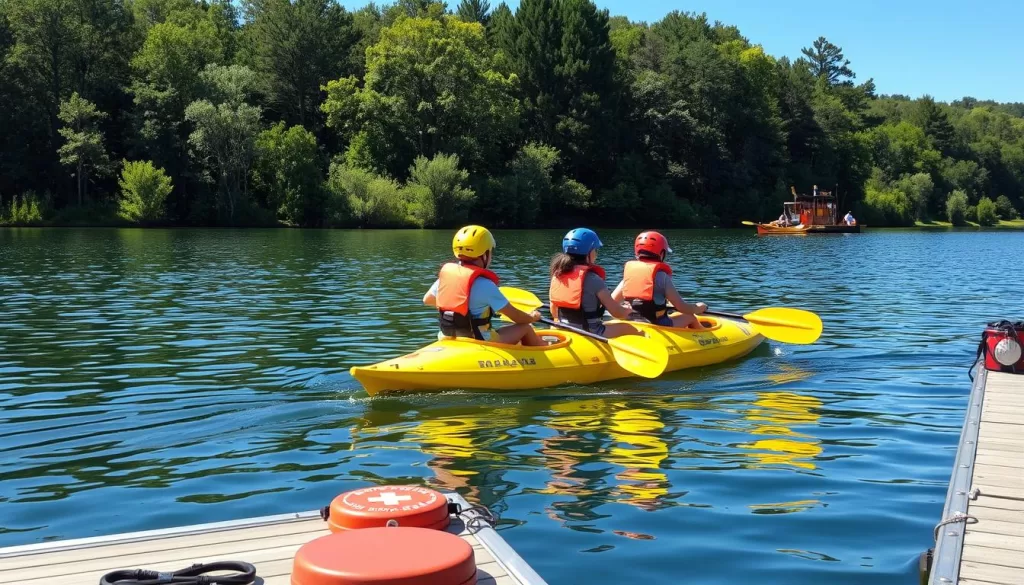
Kayaking with your kids is exciting, but safety comes first. It’s important to talk about the rules before you start. Everyone needs to know their role and the safety guidelines. This keeps the adventure safe and fun for everyone.
Communication and Rules
Talking about the rules helps everyone understand what to expect. It’s key to discuss how to behave on the water. Make sure to cover important rules like:
- Wear life jackets at all times.
- Maintain a safe distance from other kayakers.
- Follow local boating regulations.
- Pay attention to any changing weather conditions.
- Practice signals for emergencies.
Knowing these rules makes kayaking safer and builds trust among family members.
Emergency Preparedness
It’s crucial to have an emergency plan. This plan should include what to do if you tip over or get hurt. Make sure everyone knows about the safety gear, like:
- Whistles for signaling.
- First aid kits for minor injuries.
- Tow lines for emergencies.
Practicing these emergency steps makes your family feel ready and safe. Being prepared helps everyone stay together and respond quickly in emergencies.
| Emergency Preparedness Tips | Details |
|---|---|
| Capsize Procedures | Know how to stay with the kayak or swim to shore. |
| Injury Response | Use the first aid kit and call for help if needed. |
| Staying Together | Learn signals to find each other again if you get separated. |
| Equipment Check | Make sure everything works before you go out. |
| Communication Devices | Bring a waterproof phone or radio for emergencies. |
By focusing on these key points, your family can enjoy kayaking safely. Planning and getting ready makes the experience unforgettable.
Encouraging Interaction and Bonding
Kayaking is a great way for families to connect and enjoy nature together. It helps build teamwork and togetherness, making relationships stronger. Spending time on the water without screens refreshes the mind and creates lasting memories.
Quality Family Time on the Water
When families paddle together, they share special moments. The calm around them makes for deep talks, whether about nature or daily life. These moments make family bonds stronger and turn each trip into a chance to grow closer.
Building Teamwork Skills
Kayaking teaches teamwork as everyone works together to move through the water. Kids learn to respect each other’s roles and paddle as one. This helps them talk better and learn about working together and trusting each other. Overcoming challenges together builds a sense of pride and unity in the family.
| Activity | Benefits |
|---|---|
| Shared Paddling Experience | Enhances communication and cooperation |
| Exploring Nature Together | Fosters curiosity and appreciation for the environment |
| Problem-Solving Challenges | Builds resilience and teamwork skills |
Kid-Friendly Paddling Destinations
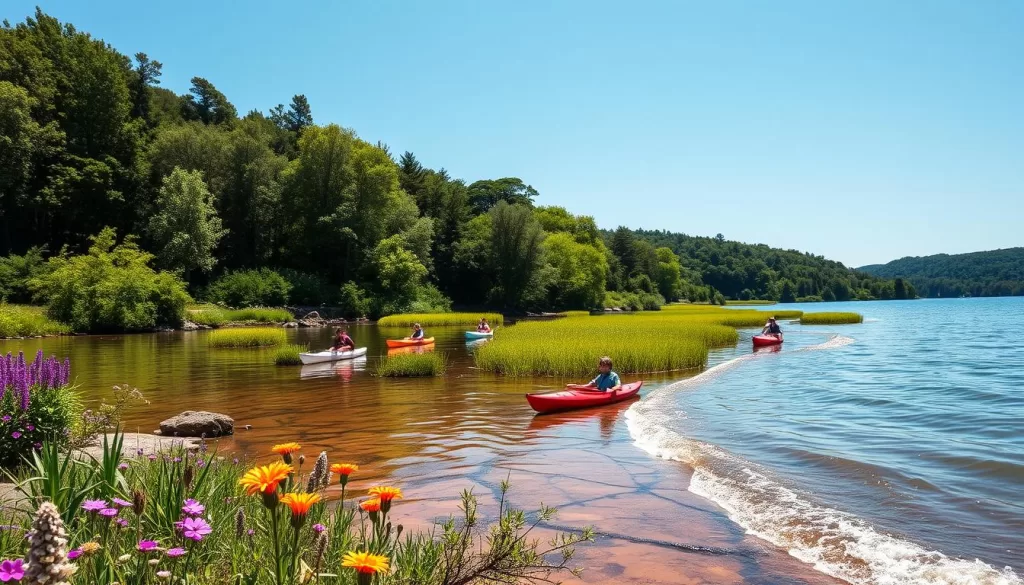
Looking for a fun adventure? Check out kid-friendly kayaking spots for a great family time. These places have calm lakes and shallow waters. They’re perfect for kids to learn and have a safe, enjoyable trip.
They also have gentle currents. This makes them great for beginners on family kayaking trips.
Calm Lakes and Shallow Waters
There are many beautiful lakes perfect for kayaking with your family. Some top spots include:
- Florida’s Big Bend near Tallahassee, with clear waters like the Wacissa River
- Wisconsin’s Door County and Apostle Islands National Lakeshore, featuring sandy beaches and rocky shores
- Minnesota’s Voyageurs National Park, known for its stunning Kabetogama Lake
Parks with Designated Kayaking Areas
Many parks have special areas for family kayaking. They offer restrooms and picnic spots to make your trip better. Here are some great places:
- Chattanooga, Tennessee, with guided tours around Audubon Island Wildlife Sanctuary
- New York City Downtown Boathouse, offering free kayaking on the Hudson River
- Ontario’s Ottawa Valley, known as Canada’s Whitewater Capital, for families who love whitewater
| Location | Type of Water | Features |
|---|---|---|
| Big Bend, Florida | Calm, spring-fed | Ideal for family day trips |
| Door County, Wisconsin | Mixed, sandy and rocky | Scenic landscapes and sea caves |
| Voyageurs National Park, Minnesota | Calm, lakes | Wildlife spotting opportunities |
| Chattanooga, Tennessee | Calm, rivers | Guided family-friendly tours |
| New York City | Urban, river | Free kayaking programs |
Participating in Kayaking Lessons
Kayaking lessons for kids turn paddling into a fun adventure. These classes teach important skills in a safe way. They are perfect for kids of all ages and skill levels.
Finding Kid-Friendly Classes
Look for classes that mix fun with learning. Some start with kids as young as five. They teach safety, technique, and how to have fun on the water.
The Dare to Kayak program is a great example. It teaches kids about river safety, conservation, and teamwork. Many students have joined, enjoying the outdoors and learning new things.
Benefits of Guided Kayaking Tours
Guided tours make kayaking special for families. They explore new places and learn about local wildlife. It’s a chance to bond and learn in nature.
Safety is key, with guides teaching the right skills and gear. There are classes for all levels, from beginners to experts. Families can find the perfect adventure.
| Age Group | Recommended Activities | Key Skills Developed |
|---|---|---|
| 5-6 years | Introductory lessons | Paddling basics, safety awareness |
| 7-9 years | Beginner paddling classes | Basic strokes, wet exits, teamwork |
| 10 years and above | Guided kayaking tours | Advanced techniques, conservation knowledge |
Joining kayaking lessons and tours makes memories with your family. You’ll enjoy nature and the excitement of paddling together.
Kayaking with Kids: Creating Lasting Memories
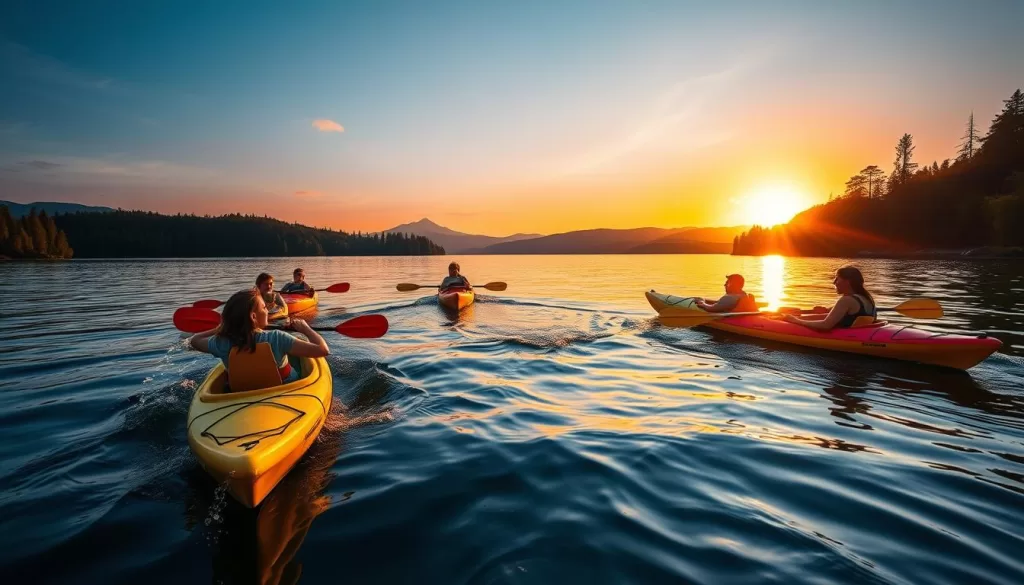
Kayaking with your family is a great way to make memories that last. Taking photos or writing in a journal helps you remember these special times. These moments become stories that you’ll tell and relive for years.
Documenting Your Adventures
Bring a waterproof camera or use your smartphone to capture the fun. It’s important to keep these memories alive. You can make a scrapbook or a digital album for your kayaking trips. This activity brings everyone together as you pick the best photos.
Looking back at these photos can make you feel closer to nature and each other.
Sharing Stories and Experiences
Telling your kayaking stories to others is powerful. Get your kids to talk about what they saw, heard, and felt on the water. This sharing builds excitement for future trips and boosts their confidence.
These stories can be passed down, making your family’s bond even stronger through shared adventures.
| Memory Capturing Method | Benefits |
|---|---|
| Photography | Visual reminders of fun moments, enhancing reminiscing |
| Journaling | Encourages reflection, deepens understanding of experiences |
| Storytelling | Strengthens family bonds, inspires future adventures |
| Scrapbooking | Creative outlet, a keepsake for future generations |
Conclusion
Kayaking with kids opens up many benefits for you and your family. It helps you all appreciate nature and builds confidence in paddling. This activity is great for growth and bringing you closer together.
Seeing your kids feel free on the water is special. In fact, 95% of kids feel a strong bond with nature after kayaking. It’s a way to connect with the outdoors.
Kayaking also makes family bonds stronger. 80% of families feel closer after kayaking together. It’s a fun way to spend time and get fit. Plus, it’s a great workout that improves coordination and endurance.
Remember, safety is key in kayaking. Having the right gear and knowing how to stay safe makes the experience better. By focusing on safety, you make sure everyone has a good time.
Keep exploring new places and enjoying kayaking as a family. With the right approach, your adventures will make lasting memories. They’ll also help you all love staying active. So, get your gear ready, enjoy the outdoors, and start kayaking with your kids!
FAQ
What age can my child start kayaking?
What safety gear do we need for kayaking with kids?
What type of kayak is best for a family?
How can I keep my kids engaged while kayaking?
What should we pack for a kayaking trip?
How do I pick a safe kayaking location for kids?
What are some basic paddling techniques for kids?
How can we prepare for unexpected weather while kayaking?
What’s the best way to build paddling endurance in kids?
Why is kayaking beneficial for my child’s development?
Source Links
- Tips for Kayaking with Kids & the Best Kids’ Kayak – https://runwildmychild.com/kayaking-with-kids/
- Kayaking with Kids: Safety Tips and Fun Ideas – https://kayakcocoabeach.com/family-kayaking/kayaking-with-kids-safety-tips-and-fun-ideas/
- Category: Intro To Kayaking: Questions Answered – https://www.kayakingkids.com/blog/category/intro-to-kayaking-questions-answered
- Kayaking with Kids Near Oakland – 510 Families – https://www.510families.com/kayaking-in-the-bay-area/
- Kayaking With Kids: A Guide To Amazing Family Adventures – https://trekkingthedream.com/kayaking-with-kids/
- Why Kayaking Is A Great Family Activity – https://kayakhiltonhead.com/why-kayaking-is-a-great-family-activity/
- Family Kayaking: Choosing a Family Kayak – https://talesofamountainmama.com/family-kayaking-choosing-a-family-kayak/
- How to Choose the Best Kayak for Your Family – https://aquabound.com/blogs/resources/how-to-choose-the-best-kayak-for-your-family?srsltid=AfmBOopYR8vrvbRK_6vFCu2dRG5gY_neuHHIJu70FZo9pxHaso9L6u2y
- Kayaking Kids Child and Youth Age Guidelines – https://www.kayakingkids.com/blog/how-old-do-your-kids-need-to-be-to-learn-to-kayak
- When to Teach Kids to Kayak & Paddleboard – https://aquabound.com/blogs/resources/when-to-teach-kids-to-kayak?srsltid=AfmBOopMcr8AHk6Pk5qybQVBmdN13VDbHolwsDfAec_lLSUraHQSEA7E
- Youngest Age for Kayaking? – https://forums.paddling.com/t/youngest-age-for-kayaking/44705
- Safety Tips for Kayaking with Kids – https://brooklynkayakcompany.com/blogs/our-blog-2/safety-tips-for-kayaking-with-kids?srsltid=AfmBOopQf0cUQ-ECWZlN5zZPZ6ENsrjK8RbFxfhZmr–uOqiUdhXjoxn
- Kayaking With Kids – An Ultimate Guide & 10 Top Tips – https://bigadventureswithlittlefeet.com/kayaking-with-kids/
- Kayak or Paddleboard??…for the kids – https://www.traveltalkonline.com/ubbthreads.php/topics/129294/kayak-or-paddleboard-for-the-kids.html
- Evolution Expeditions | Kayaking with Kids: A Family Guide – Evolution Expeditions – https://www.evolutionexpeditions.com/blog/kayaking-with-kids-a-family-guide
- KIDS AGES 11-15 PADDLING PROGRAM – https://www.collinsvillecanoe.com/module/class/363257/kids-ages-11-15-paddling-program
- Kayaking With Kids: A Practical Guide For Parents Of Paddlers-To-Be – https://www.watersportswhiz.com/kayaking-with-kids/
- Taking Your Young Kids on a Kayak or Canoe Adventure – https://www.coastalexpeditions.com/blog/paddling-with-young-kids/
- What to Bring Kayaking | Kayak Essentials | EZ Dock – https://www.ez-dock.com/blog/what-to-bring-on-a-kayak-trip/
- Beginner Tips for Canoeing With Kids • RUN WILD MY CHILD – https://runwildmychild.com/canoeing-with-kids/
- Kayaking With Kids – https://in4adventure.com/kayaking-with-kids/
- Fun Things To Do While Kayaking – https://brooklynkayakcompany.com/blogs/our-blog-2/fun-things-to-do-while-kayaking?srsltid=AfmBOoo_ua_0PxiWwycOqTdpBCpTxkl0nrv_DwIDx9axslbv9q38j38l
- Safety Tips for Kayaking with Kids – Blazin’ Paddles – https://www.blazinpaddles.com/safety-tips-for-kayaking-with-kids/
- 5 Safety Tips When Kayaking With Kids – https://www.loverskeyadventures.com/kayaking-tour/
- Kayaking with Children – Frontenac Outfitters – Frontenac Outfitters Canoe and Kayak Centre – https://www.frontenacoutfitters.com/blogs/tutorials/kayaking-with-children?srsltid=AfmBOoouHIgbdvl0LzzMgep-xsUTfkC2iw89k62VtrLgAQtW8mVXJ5mg
- Paddling with Kids: Tips for Paddling with Children | Haw River Canoe & Kayak – https://hawrivercanoe.com/paddling-with-kids-tips-for-paddling-with-children/
- Why Kayaking is Fun for Everyone – https://centralfloridakayaking.com/kayaking-safety/why-kayaking-is-fun-for-everyone/
- 15 Best Family Kayak Trips In The World – https://paddlingmag.com/trips/family-kayak-trips/
- 7 Exciting Places to Kayak with the Family – MiniTime – https://www.minitime.com/trip-tips/7-Best-Places-to-Kayak-with-the-Family-article/
- Introducing kids to kayaking – https://forums.paddling.com/t/introducing-kids-to-kayaking/15619
- Dare to Teach Kids to Kayak | Duct Tape Diaries | NRS Community – https://community.nrs.com/duct-tape/2013/06/05/dare-to-teach-kids-to-kayak/
- Kayaking with Your Kids – – https://bladenonline.com/kayaking-with-your-kids/
- 5 Reasons Why Kids Love Kayaking: A Splashing Adventure – https://elitecooler.com/blogs/news/5-reasons-why-kids-love-kayaking-a-splashing-adventure?srsltid=AfmBOoo9fPabf3s_ADqGskwjEFZ3oTWSYzvh6V26RtG-XULfwdZcw0Dr
- 5 Reasons Why Kids Love Kayaking: A Splashing Adventure – https://elitecooler.com/blogs/news/5-reasons-why-kids-love-kayaking-a-splashing-adventure?srsltid=AfmBOooq5VqIm8fydhfWAUd3fHsFznYYZHr7kPIoA9JDTC9f6VPmhz3q
- 5 Reasons to Teach Your Kids Kayaking – https://www.purewatersports.com/5-reasons-to-teach-your-kids-kayaking/
- From Tots to Teens: Why Kayaking is the Perfect Family Bonding Activity – https://www.linkedin.com/pulse/from-tots-teens-why-kayaking-perfect-family-bonding-activity

